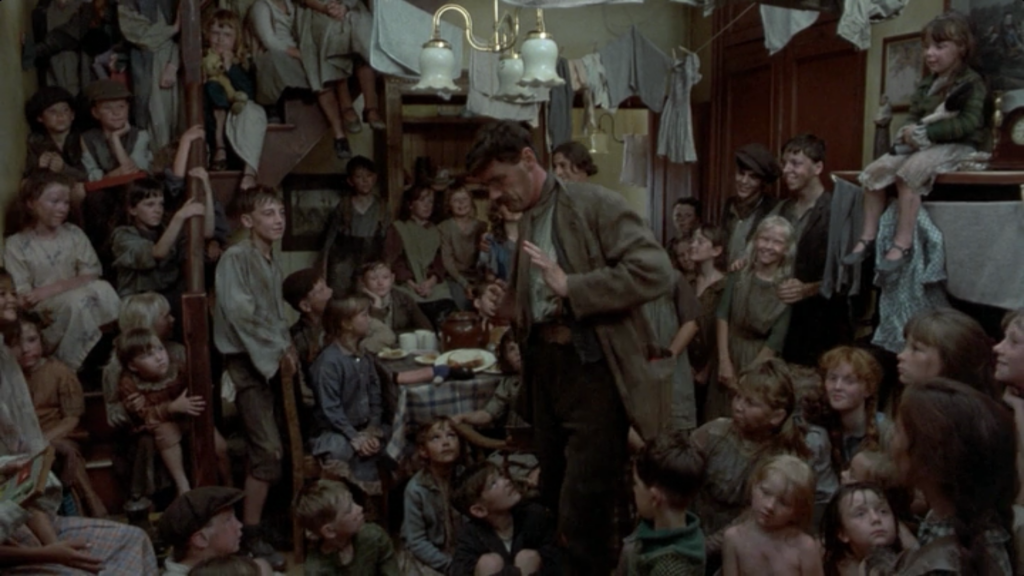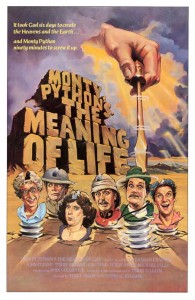|
Genres, Themes, Actors, and Directors:
- Comedy
- Episodic Films
- Monty Python Films
Review:
The Trivia section on IMDb provides some revealing insights into the inception and production of this final Monty Python collaboration, openly acknowledged by the troupe as one of its lesser (and less coherent) efforts. Python claims to have refused to show Universal Studios a script, instead relying on collective inspiration and strategic ad-libbing to produce a series of loosely linked vignettes — some of which are (inevitably) more successful than others. It opens with a Terry Gilliam-directed live short entitled “The Crimson Permanent Assurance” — originally conceived as an homage to the cinematic convention of showing a short film before the feature presentation, though in typically surreal Python fashion, it re-emerges later as part of the overall episodic arc. Next we’re presented with a developmental overview of humanity, beginning with the Miracle of Birth and proceeding through Growth and Learning, Middle Age, Live Organ Transplants (!), the Autumn Years, and Death (with the Middle of the Film and the End of the Film — as well as an exploration of the Meaning of Life — thrown in for the sake of cohesion and philosophical rigor).
Sketches in Part I (The Miracle of Birth) and Part II (Growth and Learning) are the most memorable and inspired, and could easily be considered must-see viewing in their own right — indeed, all film fanatics should likely be familiar with the magical “machine that goes ping”, with what happens when one believes that “every sperm is sacred”, and with the fact that a classroom setting can turn even a live sex act into a humdrum, yawn-inducing mundanity. Unfortunately, most of the later vignettes are decidedly less amusing, though the infamous “Mr. Creosote” sketch — in which a morbidly obese man is enjoined to eat one more “wafer thin” treat before literally exploding — should likely be endured once, simply for its cultural relevance. (Quentin Tarantino apparently admitted to finding it beyond his own considerable gruesome-tolerance level — no small admission.) Ultimately, however, film fanatics unfamiliar with Monty Python’s cinematic genius should start with their cult masterpiece, Monty Python and the Holy Grail (1975) — and decide from there whether they’re interested in exploring more.
Redeeming Qualities and Moments:
- Several genuinely surreal, hilarious, and memorable sequences

Must See?
No, though it’s obviously must-see for Monty Python fans, and certainly worth a look by all film fanatics. Listed as a Cult Movie and a Personal Recommendation in the back of Peary’s book.
Links:
|


One thought on “Monty Python’s The Meaning of Life (1983)”
A once-must, for its cult value.
Hadn’t seen this in many years. On seeing it again, it actually comes across to me as more coherent than it seems. It seems (to me, anyway) to bring forth the meaning of life in its broadest sense (fitting, after all, since this is broad comedy here).
I’m probably least pleased with Gilliam’s opening piece – though it’s mildly amusing, it’s too long and unwieldy and somewhat in wild contrast to the main film that follows. I’m also not that wild about the Creosote sketch. It makes its point – does it ever! – too well, in a way that threatens to alienate the audience.
However…I think the rest of the film holds a wonderful variety of wit. Yes, with episodic material like this, some bits are likely to be stronger than others – but what works here is in the majority. There’s certainly enough to make it worth the time of film fanatics (esp. those who value irreverent humor).
Faves:
The ‘Every Sperm Is Sacred’ sequence alone makes the entire film worth the watch (it’s a marvelous parody of ‘Oliver!’) – as well as the hilarious follow-up scene with the Protestants who live next door to the musical Catholics and give thanks to Martin Luther (“…thanks to him, my dear, I can wear whatever I want on my John Thomas!”).
The sex education class sketch shows the Python troupe in top form. As does the scene in which Death knocks during a dinner party.
I also love how the film ends – with the female tv show host (Michael Palin) summing life up very neatly: “Well, it’s nothing very special. Try to be nice to people, avoid eating fat, read a good book every now and then, get some walking in, and try and live together in peace and harmony with people of all creeds and nations. And, finally, here are some completely gratuitous pictures of penises to annoy the censors and to hopefully spark some sort of controversy, which it seems is the only way these days to get the jaded, video-sated public off their fucking arses and back in the sodding cinema. Family entertainment? Bollocks. What they want is filth: people doing things to each other with chainsaws during tupperware parties, babysitters being stabbed with knitting needles by gay presidential candidates, vigilante groups strangling chickens, armed bands of theatre critics exterminating mutant goats. Where’s the fun in pictures? Oh, well, there we are. Here’s the theme music. Goodnight.”